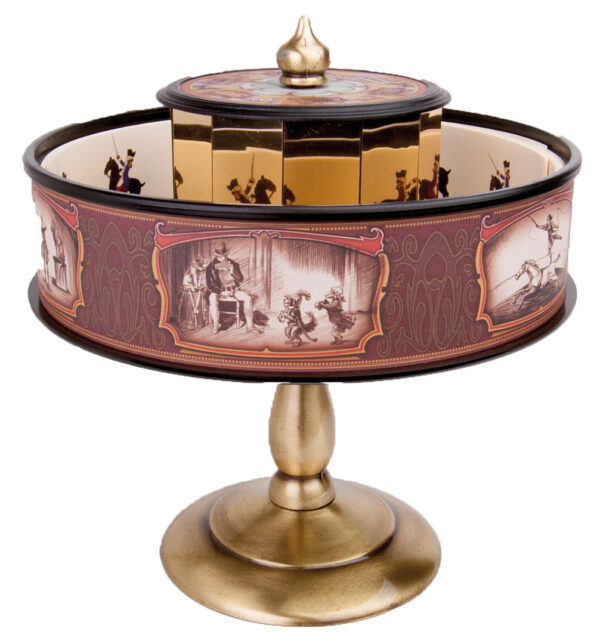Description
Reproduction in current materials of ancient instruments that are part of the cultural and scientific heritage because of their scientific, historical and aesthetic value.
The instrument is accompanied by a documentation with description in which their use is explained in detail.
Up of the first scientific games, which used animated images, through to the modern cinema, they are based on the phenomenon of persistence of the eye to reach the goal of deceiving the brain and let him believe that a number of still images in motion are. All use a similar technique: There are a series of images painted, representing each a stage of the movement. Then these images are shown in rapid succession so that the brain can not register as a single image and so the impression of a continuous movement is created (the eye can not more than 24 frames per second recognize).
Zoetrope: In 1834, the English mathematician William George Horner proposes a practical device. By the rotation of a drum, giving the illusion of moving images. He called his invention “Daedalum“. Oddly enough, the Daedalum was forgotten for almost 30 years. And suddenly, in 1867, almost at the same time it was patented in the United States and in England. Images acquired by a veiled effect of their constant movement and because they did not get enough light.
The Praxinoscope was patented by the french Emile Reynaud in 1877. In reality, Reynaud tried to enhance the shortcomings of the Zoetrope, which at that time had enormous popularity. His invention was the first, which corrected the distortion in the vision of the moving images because of insufficient light, that comb through the small slit of the Zoetrope. This improvement in image quality leading to an immediate popularity and rapid exchange of Zoetrope.
Filmstrip: Many of the animation strips, which are regarded as classics in the use of Zoetrope and Praxinoscope; are illustrations from the photographic work of the eccentric English photographer Eadweard Muybridge. Muybridge developed a mechanical and chemical techniques to capture the movement in the independent image sequences. Around 1878 he developed the “Zoopraxiscope” on the principle of the Zoetrope that allowed him the feeling of moving images to create with his photo sequences. For many transformed this invention Muybridge in the father of the animated films. From the filmstrip that we present are direct descendants of Muybridge’s work: The Rider on Horse, The rennende man, The Gymnast, Dancer Couple, The Forge and the Tiger (originally a cat).
The illustrations that adorn our devices are reproductions of originals (photographs, paintings, engravings, shape and color) of the time between 1830 and 1890.













Reviews
There are no reviews yet.